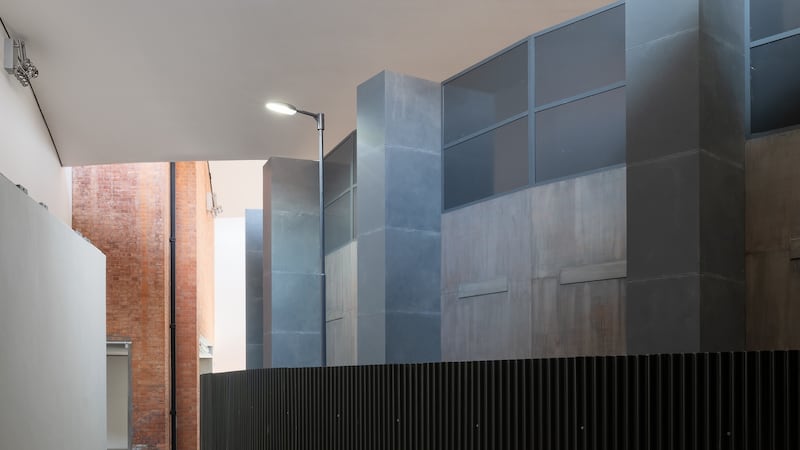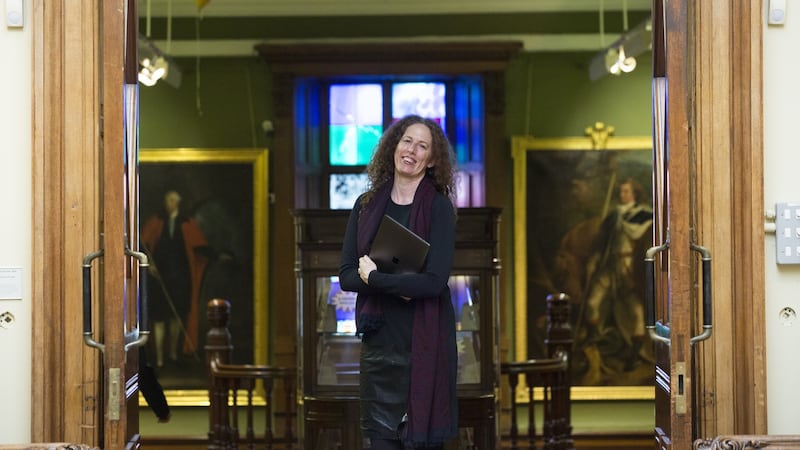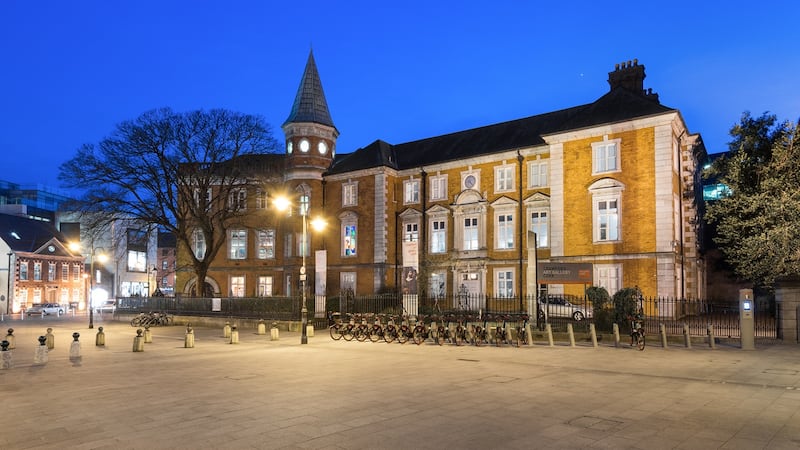Sometimes delays do not mean all is lost. And sometimes art finds its moment. Just opened at Cork's Crawford Art Gallery, Doug Fishbone's exhibition, Please Gamble Responsibly, was first scheduled for May 2020. Exactly a year later, it couldn't be more timely. The installation features a monstrous grey wall. It is a reconstruction of a Carrigtwohill ghost estate, shielded by corrugated fencing, aglow with creepy looking street lighting. Inside, a video playfully but incisively skewers the ludicrous politics that have created our housing crisis.

Experiencing it now, when it appears some people find it reasonable for vulture funds to buy up entire housing estates and apartment blocks, I can’t help feeling the exhibition ought to be required viewing for our politicians and policymakers. I also realised I had forgotten the joy of those thought-provoking moments of excitement and interest that art in a gallery can, on occasion, bring.
The idea of the occasional is something that particularly appeals to Crawford director Mary McCarthy. Her arrangements for the gallery’s reopening reflect that. “We don’t do pre-booking, we feel we have enough capacity,” she says. “We understand why other institutions need to do it, but we’re in the centre of town, we’re open seven days a week, and that idea of ‘dropping in’ has always been really important to us.”
Like so many of her sister institutions, McCarthy and her team are becoming adept at reopenings. “This is our third, or is it our fourth?,” she casts her mind back over the past 14 months as we sit far apart in an otherwise empty room, sipping takeaway coffee. Crawford’s very popular Gallery Cafe will reopen for outdoor seating on June 8th. A large marquee, put up on the grounds last year, will come into its own for the purpose.
For this reopening, a new system of contact tracing has joined the city centre venue’s arsenal of Covid-19 compliance which includes comprehensive safety information on the website, deep cleaning, visitor flow routes and sanitising stations. Now, you are welcomed at the door and invited to scan a QR code to log your details. A gallery attendant is also on hand in case QR codes and uploading details by phone aren’t your thing.

“We were asked to introduce contract tracing this time round,” McCarthy explains. “We’d had a walk-in policy before and weren’t mandated to take people’s details. We have big airy spaces and we felt people weren’t being asked in retail spaces, so why do it in the gallery? We were also conscious that people are quite harried these days, and so we wanted to reduce that.”
Consulting with colleagues, including at Dublin's Hugh Lane gallery helped the team arrive at its chosen solution. A screen at the entrance shows a traffic light, letting you know it's safe to enter and giving the numbers of visitors in the galleries at that time. Alongside the more acute losses that Covid has wrought, McCarthy is aware of some of the intangible things we have been also bereft of, including the ability to be spontaneous.
Time, she says, has lately taken on a different dimension. The ways we own time, the ways time owns us have all shifted. “We want to get a looseness back,” she says. “Booking a time for takeaways, a slot at the pub; I get anxious thinking about that already. We want to make the coming in as easy as possible, so that you don’t have to overthink it. You can come in and come back. It doesn’t have to be a scheduled activity.”
Looked at that way, art galleries are a great agent for the loosening up of time. With the exception of those blockbuster exhibitions, where your allotted spot allows you to shuffle at a pre-ordained rate past a prescribed variety of Significant Masterpieces, mostly galleries offer a calmer set of joys.
“What I love most about going,” says McCarthy, “is that I can linger in front of something. If there’s a crowd there, I can pop back. I can meet friends and say ‘hey, let’s…’.”

The Crawford has reopened with three new exhibitions, but there are also some favourites on view. “We wanted to give some touch points, so you can dive back to see old friends. People have those works that ground them.”
The Canova casts are obvious stars but I was surprised how pleased I was to see John Lavery’s portrait of his wife Hazel, The Red Rose, languidly reclining at the top of the stairs.
McCarthy believes Covid will change how museums and galleries programme; that the constant turnover of touring works, and travelling to see shows will be dialled down. She's also naturally keen to promote the gallery's own collections, given the €400,000 boost in collecting funds that came to the Cork gallery as part of a €1 million budget shared with the Irish Museum of Modern Art. Through the scheme, 422 works by 70 artists have been added to the collections.
As one of our National Cultural Institutions, the core team at Crawford are public sector employees. “We offered to work on contact tracing,” says McCarthy, but it seems they were oversubscribed. Instead, the team worked to fully inventory the collections, which I imagine to be a bit like the gallery’s version of what the rest of us were doing, or vowing to do at home, ie, cleaning out the kitchen cupboards and going through the sock drawer.
They also used the time to rehang some of the larger works, get the entire collection online, and create a stronger online presence which McCarthy believes is resulting in a younger audience profile who would initially have engaged through Instagram now visiting the gallery.
“Digital has made us infinite,” she says. Physical numbers are unsurprisingly down about 40 per cent on the same time in 2019. “That’s expected as we have no real domestic and international travel yet.” The gallery is averaging about 350 visitors a day; double that at weekends. “I had a fear that the public may not come back, that they might not feel safe, that our older audiences may not feel comfortable leaving their homes, but it turns out that there’s a high level of loyalty that we shouldn’t take for granted.”
The arts are also at last making their presence felt on the Government agendas. “I was thrilled that the Taoiseach announced at the top of the news that museums and galleries were to open. The whole narrative up until then had been about sport. It took a lot of work to make that happen.”
Amid the plans for reopening the Crawford is also looking towards another closure – but not, McCarthy hopes, until the end of 2022. Then, a huge building project will extend, renovate and open new spaces to the public, in what she describes as the biggest reworking of the building in 200 years.
Wandering through the galleries there was the quiet enjoyment of the still unusual sense of being around people who aren’t to be experienced as toxic threats but as fellow beings, sharing an experience. I was also surprised to rediscover a new relationship to yellow. Once in this country, orange was a loaded colour, but now looking at the walls in the ground floor gallery, I began to wonder how long it may take for yellow to lose its Covid associations. Dara McGrath’s For Those That Tell No Tales shows a series of photographs uncannily documenting sites of killings during the War of Independence – many of them tranquil or otherwise unremarkable spots today. Life, in the Crawford, goes on.

















